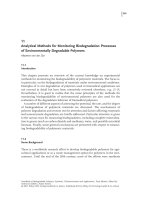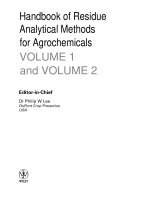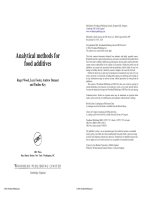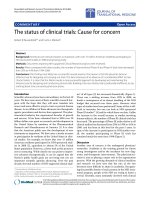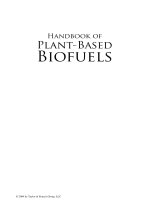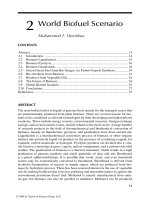Handbook of Residue Analytical Methods for Agrochemicals pot
Bạn đang xem bản rút gọn của tài liệu. Xem và tải ngay bản đầy đủ của tài liệu tại đây (9.9 MB, 1,428 trang )
Editor-in-Chief
Dr Philip W Lee
DuPont Crop Protection
USA
Handbook of Residue
Analytical Methods
for Agrochemicals
VOLUME 1
and VOLUME 2
Copyright
C
2003 John Wiley & Sons Ltd, The Atrium,
Southern Gate, Chichester,
West Sussex PO19 8SQ, England
Telephone (+44) 1243 779777
Email (for orders and customer service enquiries):
Visit our Home Page on www.wileyeurope.com or www.wiley.com
All Rights Reserved. No part of this publication may be reproduced, stored in a retrieval
system or transmitted in any form or by any means, electronic, mechanical, photocopying,
recording, scanning or otherwise, except under the terms of the Copyright, Designs and
Patents Act 1988 or under the terms of a licence issued by the Copyright Licensing Agency
Ltd, 90 Tottenham Court Road, London W1T 4LP, UK, without the permission in writing of
the Publisher. Requests to the Publisher should be addressed to the Permissions Department,
John Wiley & Sons Ltd, The Atrium, Southern Gate, Chichester, West Sussex PO19 8SQ,
England, or emailed to , or faxed to (+44) 1243 770620.
This publication is designed to provide accurate and authoritative information in regard to the
subject matter covered. It is sold on the understanding that the Publisher is not engaged in
rendering professional services. If professional advice or other expert assistance is required,
the services of a competent professional should be sought.
Other Wiley Editorial Offices
John Wiley & Sons Inc., 111 River Street, Hoboken, NJ 07030, USA
Jossey-Bass, 989 Market Street, San Francisco, CA 94103-1741, USA
Wiley-VCH Verlag GmbH, Boschstr. 12, D-69469 Weinheim, Germany
John Wiley & Sons Australia Ltd, 33 Park Road, Milton, Queensland 4064, Australia
John Wiley & Sons (Asia) Pte Ltd, 2 Clementi Loop #02-01, Jin Xing Distripark, Singapore
129809
John Wiley & Sons Canada Ltd, 22 Worcester Road, Etobicoke, Ontario, Canada M9W 1L1
Wiley also publishes its books in a variety of electronic formats. Some content that appears in
print may not be available in electronic books.
Where articles in the Handbook of Residue Analytical Methods for Agrochemicals have been
written by government employees in the United States of America, please contact the
publisher for information on the copyright status of such works, if required. Works written by
US government employees and classified as US Government Works are in the public domain
in the United States of America.
Preface
The agrochemical industry is, globally, one of the most heavily regulated industries
today. Extensive product chemistry, environmental fate, residue chemistry, ecotoxi-
cology, and mammalian toxicology data are required to support the registration and
reregistration of all crop protection products. This information is used not only to
conduct human dietary and worker exposure risk assessments but also to determine
the potential impact of the agrochemicals and their degradation products/metabolites
on the environment and sensitive ecosystems. The quality of the residue data, includ-
ing the reliability and sensitivities of the analytical methods and the validity of the
collected biological/environmental samples,is critical to the acceptability and validity
of the risk characterization/assessment. Differences in testing guidelines between the
various regulatory authorities and the lack of standardization in test method specifica-
tions further complicate the interpretation and broad application of the exposure data.
Significant progress has been achieved in residue analytical technology in the past
50 years. Today’s residue analytical methodology detects multiple analytes routinely
at the nanogram per kilogram (ppt) level in a wide variety of sample matrices with
a high level of selectively and accuracy. The role of the residue analytical chemist
is no longer limited to the development and validation of analytical methods but
also includes design and conduct of complex field crop residue and environmental
monitoring studies. This is a real challenge, especially when studies are conducted
under the strict Good Laboratory Practices guidelines.
Recognizing the diverse and rapid growth of residue chemistry as an important
scientific discipline, Dr Terry Roberts, Founding Editor of the Handbook of the
Residue Analytical Methods of Agrochemicals, organized this publication effort in
1999. The editorial team includes Dr Hiro Aizawa (Hiro Research Consultancy),
Dr Al Barefoot (DuPont Crop Protection) and Dr John Murphy (Bayer CropScience).
The scope/objective of this handbook is to present to the reader a comprehensive
overview of current global regulatory requirements and the application of various
analytical technologies (chromatographic and non-chromatographic) to residue anal-
ysis. Best practices to conduct various crop residue and field monitoring studies and
detailed method procedures for the determination of major classes of agrochemicals,
as well as individual compounds, are key components of this handbook.
This handbook consists of two volumes and approximately 80 individual chap-
ters. The editorial team acknowledges the high quality of the contributions from the
regulatory, academic, and industrial researchers around the world. It is their commit-
ment in time and effort that make this a successful publication project. Each chapter
was reviewed by at least one editor and often by other technical experts. The editorial
team acknowledges the generous advice and reviews provided by our colleagues from
DuPont Crop Protection (Dr Wynn John, Dr Chuck Powley) and Bayer CorpScience
(Dr Lou Russo), the US EPA (Dr Alex Krynitsky) and the USDA ARS (Dr David
Smith). We would also appreciate comments, feedback and upgrades from the readers,
so that correction and improvement can be made for later editions or printings.
xli
xlii Preface
The editorial team is also grateful for the valuable support from the Publisher (John
Wiley & Sons Ltd.), in particular Ms Lynette James, and from the Project Manager
(Gray Publishing), in particular Ms Lesley Gray, for their efficient coordination during
the planning, review and production phase of this publication effort.
Finally, this handbook is dedicated to all past and present residue analytical
chemists. It is their vision and creativity that continues to push back the frontier
of residue analytical technology.
Philip W. Lee
Newark, Delaware
December, 2002
Editorial Board
Editor-in-Chief
Dr Philip W Lee
DuPont Crop Protection
Stine-Haskell Research Center
Newark
Delaware
USA
Associate Editors
Professor Hiroyasu Aizawa Dr Aldos C Barefoot Dr John J Murphy
Hiro Research Consultancy DuPont Crop Protection Dietary Exposure
Inc.(HRCI) Stine-Haskell Research Center Bayer CropScience
Tokyo Newark Stilwell
Japan Delaware Kansas
USA USA
Founding Editor
Dr Terry Roberts
Anglesey
North Wales
UK
List of contributors
Lutz Alder Federal Institute for Health Protection of
Consumers and Veterinary Medicine (BgVV), Berlin,
Germany
Todd A. Anderson Texas Tech University, Lubbock,
TX, USA
Reiner Bacher PTRL Europe GmbH, Ulm, Germany
Michael R. Barrett United States Environmental
Protection Agency, Washington, DC, USA
Elizabeth Behl United States Environmental Protection
Agency, Washington, DC, USA
Kimberly S. Billesbach Bayer CropScience, Stilwell,
KS, USA
James F. Brady Syngenta Crop Protection, Inc.,
Greensboro, NC, USA
David J. Brookman Technology Sciences Group Inc.,
Washington, DC, USA
Thomas J. Burnett Eli Lilly and Company, Greenfield,
IN, USA
Maria Elena Y. Cabusas DuPont Crop Protection,
Newark, DE, USA
Leslie S. Carver Waterborne Environmental, Inc.,
Leesburg, VA, USA
Andrey Chen FMC, Princeton, NJ, USA
Joseph R. Chepega Waterborne Environmental, Inc.,
Leesburg, VA, USA
Mihai Cicotti Battelle Memorial Institute, Geneva,
Switzerland
Thomas J. Class PTRL Europe GmbH, Ulm, Germany
George P. Cobb Texas Tech University, Lubbock, TX,
USA
Johannes Corley Rutgers, The State University of New
Jersey, North Brunswick, NJ, USA
Kay K. Curry Technology Sciences Group Inc.,
Washington, DC, USA
William J. Englar Englar Food Laboratories, Inc.,
Moses Lake, WA, USA
Cheryl M. Englar-Coulter Englar Food Laboratories,
Inc., Moses Lake, WA, USA
Neal Ewing National Food Laboratory, Inc., Dublin,
CA, USA
John Fuhrman Monsanto, St. Louis, MO, USA
Richard J. Fussell Central Science Laboratory, York,
UK
Willa Garner GARNDAL Associates, Inc., Mount
Airy, MD, USA
Shirley J. Gee University of California, Davis, CA,
USA
Thomas J. Gould Bayer CropScience, Stilwell, KS,
USA
Timothy J. Grace Bayer CropScience, Stilwell, KS,
USA
Charles A. Green Valent USA Corporation, Dublin,
CA, USA
Amy Hackett Monsanto, St. Louis, MO, USA
Bruce D. Hammock University of California, Davis,
CA, USA
Ralf H¨anel Federal Biological Research Centre for
Agriculture and Forestry (BBA), Braunschweig, Germany
Vincent Hebert Washington State University, Richland,
WA, USA
xliv List of contributors
Andrew J. Hewitt Stewart Agricultural Research
Services, Macon, MO, USA
Richard Honeycutt H.E.R.A.C., Inc., Greensboro, NC,
USA
Mitsumasa Ikeda Kumiai Chemical Industry Co., Ltd,
Shizuoka, Japan
Yuji Ikemoto Nihon Nohyaku Co. Ltd, Osaka, Japan
Fujio Ishijima Hokko Chemical Industry Co. Ltd,
Kanagawa, Japan
Scott H. Jackson BASF Corporation, Research
Triangle Park, NC, USA
Kathryn M. Jernberg DuPont Crop Protection,
Newark, DE, USA
William W. John DuPont Crop Protection, Stine
Haskell Research Center, Newark, DE, USA
Setsuko Katsurada Sankyo Co. Ltd, Shiga, Japan
Guenther Kempe Landesuntersuchungsanstalt,
Chemnitz, Germany
Douglas E. Kiehl Eli Lilly and Company, Greenfield,
IN, USA
Philip James Kijak US Food and Drug Administration,
Laurel, MD, USA
Hiroko Kobayashi Research Institute of Japan Plant
Protection Association, Ibaraki, Japan
Alexander J. Krynitsky US Environmental Protection
Agency, EPA Environmental Science Center, Fort Meade,
MD, USA
Chung K. Lam Bayer CropScience, Stilwell, KS, USA
Steven J. Lehotay USDA Agricultural Research
Service, Eastern Regional Research Center, Wyndmoor,
PA, USA
William M. Leimkuehler Bayer CropScience, Stilwell,
KS, USA
James S. LeNoir DuPont Crop Protection, Newark, DE,
USA
Yi Lin Syngenta Crop Protection, Inc., Greensboro, NC,
USA
Cynthia Lipton Byotix, Inc., Richmond, CA, USA
Joseph H. Massey Mississippi State University,
Starkville, MS, USA
Greg C. Mattern Bayer CropScience, Stilwell, KS,
USA
Joseph P. McClory DuPont Crop Protection, Newark,
DE, USA
Carolyn Mentzer Agrisearch Incorporated, Thurmont,
MD, USA
D. Larry Merricks Agrisearch Incorporated, Frederick,
MD, USA
Sean M. Moore Bayer CropScience, Stilwell, KS, USA
Kouji Nakamura Saitama Prefecture Agriculture and
Forestry Research Center, Kuki, Japan
Kazuo Ogura Agricultural Chemicals Inspection
Station, Tokyo, Japan
Jeff Old Inveresk Research, Tranent, UK
Takeo Otsuka Sankyo Co. Ltd, Shiga, Japan
John C. Peterson Englar Food Laboratories, Inc.,
Moses Lake, WA, USA
Beth M. Polakoff Exponent, Inc., Washington, DC,
USA
Charles R. Powley DuPont Crop Protection, Newark,
DE, USA
Robin S. Readnour Eli Lilly and Company, Greenfield,
IN, USA
Valerie B. Reeves US Food and Drug Administration,
Rockville, MD, USA
List of contributors xlv
Stewart L. Reynolds Central Science Laboratory, York,
UK
Neil J. Robinson Syngenta, Bracknell, UK
Janine E. Rose PTRL West, Inc., Hercules, CA, USA
Louis Russo Bayer CropScience, Kansas City, MO,
USA
Mariko Sabi Sankyo Co. Ltd, Shiga, Japan
Shingo Sadakane Sankyo Co. Ltd, Shiga, Japan
Manasi Saha BASF Corporation, Research Triangle
Park, NC, USA
Takashi Saito Sankyo Co. Ltd, Shiga, Japan
Yoshihiro Saito Kumiai Chemical Industry Co., Ltd,
Shizuoka, Japan
Thomas Schreier Valent USA Corporation, Dublin,
CA, USA
James N. Seiber Western Regional Research Center,
USDA Agricultural Research Service, Albany, CA, USA
Robert J. Seymour Bayer CropScience, Research
Triangle Park, NC, USA
Guomin Shan Dow AgroSciences LLC, Indianapolis,
IN, USA
Weilin L. Shelver US Department of Agriculture,
Agricultural Research Service, Fargo, ND, USA
Johannes Siebers Federal Biological Research Centre
for Agriculture and Forestry (BBA), Braunschweig,
Germany
David J. Smith US Department of Agriculture,
Agricultural Research Service, Fargo, ND, USA
Craig A. Smitley Scynexis, Research Triangle Park,
NC, USA
Lisa D. Spurlock-Brouwer Eli Lilly and Company,
Greenfield, IN, USA
Guy R. Stehly USGS, Biological Resources Division,
La Crosse, WI, USA
Shigeji Sugimoto Nippon Soda Co. Ltd, Tokyo, Japan
Manabu Toujigamori Sankyo Co. Ltd, Shiga, Japan
Yasuhiro Tsujino Sankyo Co. Ltd, Shiga, Japan
Michael P. Turberg Eli Lilly and Company, Greenfield,
IN, USA
Takashi Ueda Sankyo Co. Ltd, Shiga, Japan
Masako Ueji National Institute for Agro-Environmental
Sciences, Tsukuba, Japan
Noriharu Umetsu Otsuka Chemical Co. Ltd, Naruto,
Japan
David L. Valcore Dow AgroSciences, Indianapolis, IN,
USA
Chantel Van Bellinghan Monsanto, Brussels, Belgium
Michael F. Wilson Central Science Laboratory, York,
UK
James E. Woodrow University of Nevada, Reno, NV,
USA
Akira Yagi Kumiai Chemical Industry Co., Ltd,
Shizuoka, Japan
Katsura Yagi Otsuka Chemical Co. Ltd, Naruto,
Japan
Hisayoshi Yamagishi Research Institute of Japan Plant
Protection Association, Ibaraki, Japan
Hiroki Yamamoto Shimane University, Matsue,
Japan
Robert A. Yokley Syngenta Crop Protection, Inc.,
Greensboro, NC, USA
Sabrina X. Zhao Pfizer Inc., Groton, CT, USA
Eberhard Zietz Institut Fresenius, Taunusstein,
Germany
Contents of Volume 1
Preface xli
List of contributors
xliii
Introduction
James N. Seiber 1
Introduction 1
Relationship of pesticide residue analysis, regulation, and risk assessment 4
Who does residue analysis and why 5
Challenges 7
References 8
Regulatory guidance and scientific consideration for residue
analytical method development and validation
Assessment of residue analytical methods for crops, food, feed, and
environmental samples: the approach of the European Union
Johannes Siebers and Ralf H
¨
anel 13
Introduction 13
Legal background 14
General 14
Council Directive 91/414/EEC 14
Legislation related to MRLs 15
Legislation related to residues limits for soil, water, and air 18
Provisions for residue analytical methods 18
Evaluation of the submitted methods 20
Institutional background 20
Validation parameters 21
Requirements for post-registration and monitoring (enforcement) methods 23
General requirements 23
Specific requirements 27
Requirements for data generation methods 31
General requirements 32
Specific requirements 33
Availability of analytical methods 34
Perspectives 35
Acknowledgement 36
References 36
v
vi Contents of Volume 1
Regulatory considerations for residue analysis and methods on crops and food:
the approach of Japan
Kazuo Ogura, Hisayoshi Yamagishi and Shigeji Sugimoto 38
Background 38
Plant metabolism studies 40
Residue studies on crops 41
Residue analytical method 41
Preferred methodology for conducting supervised field trials 41
Field data (field report) presentation 46
Extrapolation among the formulation types 47
Residue definition 47
Market basket survey in Japan 48
Conclusion 49
Further reading 49
General approaches for residue analytical method development and validation
Thomas J. Class and Reiner Bacher 50
Introduction 50
Approaches to analytical method development 51
Properties of the analyte(s) 51
Functional groups of the analyte(s) 52
Properties of the sample material 53
Availability and practicality of analytical instrumentation 54
Consideration of time, throughput, ruggedness and quality 54
Practical examples 55
Extending the scope of the multi-residue method DFG S19 55
What can go wrong? 57
Beyond the limits 58
References 58
Best practices in establishing detection and quantification limits for pesticide
residues in foods
Johannes Corley 59
Introduction 59
Definitions 61
Methods for defining LOD and LOQ 63
IUPAC method 63
Propagation of errors method 66
Hubaux–Vos approach 67
Two-step approach (proposed by the US EPA) 67
RMSE method 68
The t
99
s
LLMV
method 70
Confirmation 71
Representative data 72
Conclusions 73
Acknowledgements 74
References 74
Contents of Volume 1 vii
The process of development and validation of animal drug residue methods for
US Food and Drug Administration regulatory use
Philip James Kijak and Valerie B. Reeves 76
Introduction 76
The method 78
Determinative procedures 79
Confirmatory procedures 79
Development of methods for regulatory use 80
Practicability of methods 80
Analyte selection 80
Specificity 81
Ruggedness 81
Stability 82
System suitability 82
Method criteria 83
Standards 83
Precision 83
Accuracy 84
Other considerations 84
Confirmatory procedure criteria 85
Standard operating procedures (SOPs) 85
Determinative procedure 85
Confirmatory procedure 87
Other considerations 87
The method trial 88
Second analyst/laboratory check 88
FDA review 88
Inter-laboratory method trial 89
Confirmatory procedure method trial 91
Non-NADA method trial 91
Evaluation of data and recommendation for use 92
Conclusion 92
References 93
Validation of analytical methods for post-registration control and monitoring
purposes in the European Union
Lutz Alder 94
Introduction 94
Evaluation of enforcement methods for food provided by manufacturers 95
The need for enforcement methods from the applicant 95
The problem with residue definition 96
Elements and format of method description 98
Assessment of validation results 101
Matrices in validation experiments 105
Test of multi-residue methods 107
Independent laboratory validation 108
Statement on extraction efficiency 108
Perspectives 109
viii Contents of Volume 1
Validation of European standard (CEN) methods 110
Scope and format of CEN methods 110
CEN requirements for widely accepted multi-matrix/multi-residue methods 112
Requirements for (newer) methods with limited scope 112
Assessment and documentation of validation results 113
Validation of official methods of EU member states 115
Overview of existing method collections and validation requirements 115
Single-laboratory validation in the UK 115
Validation procedures of the Nordic countries 119
Validation of official methods in Germany 124
The problem of appropriate documentation of validation data
of multi-matrix/multi-residue methods 127
Summary and conclusion 128
References 130
Best practices in the generation and analysis of residues in crop,
food and feed
Conducting crop residue field trials in the USA
William W. John 135
Introduction 135
Description of the different types of field crop residue studies 137
EPA guidelines and requirements 137
Planning phase 140
Testing strategy 140
Crop and crop grouping 141
Site/location selection 143
Good Agricultural Practice (GAP) and use patterns 144
Test substance 145
Residue decline trials 145
Processing study requirement 146
Contract research organizations 147
Best practices in conducting field study 148
Protocol development 148
The test site 149
Test material 153
Application phase 155
Sampling phase 157
Sample storage and shipping 159
Sample preparation 162
Field QA components 163
Data presentation and communication 165
Summary 167
References 167
Contents of Volume 1 ix
Conducting crop residue field trials in Europe
Jeff Old 169
Introduction 169
General issues and considerations in conducting residue studies in Europe 169
Regulation guidelines 169
European comparable climatic zones/weather influences 170
Crop and grouping 170
Study planning phase 173
Study objectives 173
Role and responsibility of study personnel 173
Preparing the study plan 176
Product use pattern 177
Test site requirements, evaluation and selection 177
Best practices to conduct field studies 178
Evaluation and selection of field investigators and testing personnel 178
Preparation of field testing study plan 179
Test item (previously termed test substance) 179
Trial layout 180
Growing and maintenance of trial site crops 181
Calibration/servicing of application equipment 181
Test item application 182
Sampling of crops 184
Sample shipping and transportation 188
Sample storage 189
Record keeping 191
Good Laboratory Practice 193
Field QA audits and study involvement 194
Archiving 195
Conclusion 196
Further reading 197
Conducting crop residue field trials in Mexico and Latin America
Louis Russo 198
Introduction 198
Regulatory requirements 199
Planning a field residue trial in Latin America 201
Number and locations of trials 201
Personnel requirements 202
Protocol preparation 203
Test materials 203
Quality assurance 204
Budget considerations 204
Communications 206
Pre-implementation activities 206
Translation of critical documents 206
Preparation of the field notebook formats 207
Pre-meetings in testing regions 207
Implementation of testing procedures 210
GLP training and protocol discussion 210
Safety training 211
x Contents of Volume 1
First application 211
Sampling and shipping 212
Food Quality Protection Act (FQPA) considerations 213
Reporting and closure 213
Abbreviations 213
Food processing of raw agricultural commodities for residue analysis
William J. Englar, Neal Ewing, John C. Peterson and
Cheryl M. Englar-Coulter 215
Overview of processing of agricultural commodities 215
Historical background 215
Basis for selecting a process method 216
Laboratory/pilot processing of agricultural commodities 218
Processing requirements of individual agricultural commodities 218
Pilot laboratory processing versus commercial processing 219
Effect of processing on pesticide residues 223
Good Laboratory Practice (GLP) regulations and their impact on the
small-scale processing procedures 224
Development and validation of SOPs 224
Development of processing protocol 224
Role of study personnel 226
Protocol deviations 227
Organization of a processing report 227
Raw data notebook 227
Summary report of processing procedures 228
Summary 230
References 230
Best practices in the implementation of a large-scale market basket residue
survey study
David J. Brookman, Kay K. Curry and Beth M. Polakoff 231
Introduction 231
General considerations 231
Case study (Organophosphates Market Basket Survey) 232
Development of study protocol 233
Definition of study objectives 234
Role and responsibilities of study personnel 235
Selection of products and of properties to be evaluated 236
Sample collection strategy 237
Analyses and data reporting 238
Implementation of sampling plan 239
Shopper selection and training 239
Sample collection, storage, shipment, receipt, and documentation 240
Analytical phase 241
Analytical method 241
Obtaining control commodities 242
Assignment of products to laboratories 242
Standardization of results reporting 243
Presentation and review of study findings 245
Contents of Volume 1 xi
Quality assurance functions 246
Interpretation of study findings 247
Procedures and best practices for conducting residue studies of animal health
drugs in food animals
David J. Smith, Guy R. Stehly and Michael P. Turberg 248
Introduction 248
Purpose of residue studies 249
Studies sponsored by the animal health industry 249
Other studies 257
Protocol development 259
Animal selection and animal receipt 261
Animal considerations for GLP studies 262
Other considerations in animal selection 264
Preparation of test article 265
Animal dosing 267
Oral administration 268
Parenteral administration 271
Other methods of drug administration 272
In-life sample collection 274
Facility considerations 274
Animal weights, feed and water intakes, and dose 275
Nutritional and environmental considerations 276
Sample collection 276
Residue analysis 281
Radiochemical analysis 281
Analysis of the marker residue 283
Quality control 291
Report 292
Conclusions 292
References 293
Sampling and analyses of foodstuffs from animal origin
Robin S. Readnour, Thomas J. Burnett, Douglas E. Kiehl
and Lisa D. Spurlock-Brouwer 300
Introduction 300
Sample collection and storage 302
Sampling and homogenization 302
Stability 303
Extraction and sample preparation 304
Extraction 304
Sample preparation 307
Separation and detection 310
Liquid chromatography 311
Liquid chromatography/mass spectrometry 314
Gas chromatography 315
Immunoassay 317
Data handling and presentation 318
Method validation 319
xii Contents of Volume 1
Regulatory guidelines 319
Inter-laboratory/collaborative studies 321
Conclusion 321
References 321
Compound class
Anilides
Hiroko Kobayashi 327
Introduction 327
Residue analytical methods for plant materials 327
Nature of the residue 327
Analytical method 329
Residue analytical methods for soil 336
Nature of the residues 336
Analytical method 336
Analytical methodology for water 339
Nature of the residues 339
Analytical method 339
References 342
Chloroacetanilide herbicides
Amy Hackett, John Fuhrman and Chantel Van Bellinghan 344
Introduction 344
Analytical methodology for plant and animal products 347
Nature of the residue 347
Rationale for the presented methods 347
Description of methodology 347
Analytical methodology for water and soil 348
Nature of the residue 348
Rationale for the methods presented 349
Description of methodology 350
Analytical method for the determination of acetochlor and its metabolites
in plants and animals 350
Outline of method 351
Apparatus 351
Reagents 352
Analytical standards 354
Analytical procedure 355
Instrumentation 359
Calculation of residues 359
Evaluation 360
Analytical method for the determination of propachlor and its metabolites
in plants and animals 361
Outline of method 361
Apparatus 361
Reagents 362
Analytical standards 363
Analytical procedure 363
Instrumentation 366
Contents of Volume 1 xiii
Calculation of residues 367
Evaluation 367
Multi-residue analytical method for the determination of acetochlor, alachlor,
and metolachlor in aqueous samples 368
Outline of method 369
Apparatus 369
Reagents 370
Analytical standards 371
Analytical procedure 373
Calculation of residues 376
Evaluation 377
Multi-residue analytical method for the determination of acetochlor, alachlor,
and metolachlor soil metabolites in aqueous samples 378
Outline of method 380
Apparatus 380
Reagents 381
Analytical standards 381
Analytical procedures 382
Calculation of residues 385
Evaluation 385
Future directions for environmental monitoring 387
Acknowledgements 387
References 387
Dinitroaniline herbicides
Masako Ueji 389
Introduction 389
Analytical methodology for plant materials 390
Nature of the residues 390
Method principle 391
Analytical methodology for soil 395
Nature of the residues 395
Method principle 395
Analytical method for soil metabolites 397
Analytical methodology for water 398
Nature of the residues 398
Analytical method 398
References 399
Sulfonylurea herbicides
Charles R. Powley 400
Introduction 400
Analytical methodology 402
LC/MS/MS analysis 402
Crops, food and feed 405
Soil 407
Water 408
Conclusions and future directions 409
Acknowledgements 410
References 410
xiv Contents of Volume 1
Triazine herbicide methodology
Robert A. Yokley 412
Introduction/general description 412
Analytical methodology for water samples 416
Water sample preparation 416
Analytical methodology for soil samples 429
Liquid–solid extraction 430
Sonication 431
Microwave extraction 432
Supercritical fluid extraction 432
Subcritical fluid extraction 434
On-line SFE 435
Analytical methodology for crops, food, feed, and animal tissues 435
Analytical methodology for biological fluids 437
Analytical methodology for air samples 438
Instrumentation 439
Gas chromatography 439
Liquid chromatography 441
Supercritical fluid chromatography 442
Electrochemical analysis 443
Other techniques 443
Future directions 443
References 445
Diphenyl ethers
Masako Ueji 451
Introduction 451
Analytical methodology for plant materials 453
Nature of the residues 453
Analytical method 453
Analytical methodology for soil 458
Nature of the residues 458
Analytical method 459
Analytical method for the metabolites of diphenyl ether herbicides in soil 460
Analytical methodology for water 461
Nature of the residues 461
Analytical method 462
References 464
Individual compounds
Bispyribac-sodium
Yoshihiro Saito, Mitsumasa Ikeda and Akira Yagi 469
Introduction 469
Outline of method 469
Apparatus 470
Reagents 470
Sampling and sample preparation 471
Contents of Volume 1 xv
Procedure 471
Extraction 471
Cleanup 472
Gas-chromatographic determination 473
Evaluation 473
Method 473
Recoveries, limit of detection and limit of determination 473
Calculation of residues 474
Important points 474
Carfentrazone-ethyl
Audrey Chen 475
Introduction 475
Outline of method 476
Apparatus 477
Reagents 479
Sampling and preparation 479
Analytical procedures for nonoil crop matrices 480
Sample extraction, filtration and concentration 480
Partition 480
Determination of carfentrazone-ethyl 480
Determination of acid metabolites 481
Analytical procedures for crop refined oils 482
Analytical procedures for animal matrices 483
Instrumentation 483
Method validation and quality control 484
Experimental design 484
Preparation of standards 484
Calculation 485
Time required for analysis 486
Accuracy and precision 486
Important points 486
Storage stability 488
Acknowledgements 488
Flucarbazone-sodium
Thomas J. Gould and Chung K. Lam 489
Introduction 489
Outline of method 490
Apparatus 490
Reagents and consumable supplies 491
Sampling and preparation 491
Procedure 491
Extraction 491
Cleanup/concentration 492
Chromatographic determination 493
Evaluation 494
Method 494
Recoveries, limit of detection and limit of quantitation 495
Calculation of residues 496
xvi Contents of Volume 1
Important points 497
References 497
Flumetralin
Robert A. Yokley 498
Introduction 498
Outline of methods 498
Apparatus 499
Reagents 499
Sample preparation 499
Soil 499
Plant materials 500
Instrumentation 500
Evaluation 501
Method 501
Recoveries, limit of detection (LOD) and limit of quantitation (LOQ) 501
Calculation of residues 501
Reference 501
Flumioxazin
Thomas Schreier 502
Introduction 502
Outline of method 503
Plant matrices 503
Soil 503
Water 503
Apparatus 503
Reagents 503
Sampling and preparation 504
Procedure 504
Extraction 504
Cleanup 505
Determination 506
Evaluation 507
Method 507
Recoveries, limit of detection and limit of quantitation 507
Calculation of residues 507
Important points 508
Isoxaflutole
Robert J. Seymour, Craig A. Smitley and Sabrina X. Zhao 509
Introduction 509
Outline of method 510
Reagents and standards 510
Equipment and supplies 510
Sampling and preparation 511
Extraction procedure 511
Manual procedure 511
Contents of Volume 1 xvii
Automated procedure using a Zymark Benchmate Workstation with
EasyFill module 512
Determination by LC/MS/MS 514
Evaluation 515
Performance criteria 515
Recoveries, limit of detection and limit of quantifiation 515
Calculation 515
Orbencarb
Mitsumasa Ikeda, Yoshihiro Saito and Akira Yagi 519
Introduction 519
Outline of method 519
Equipment 520
Reagents 520
Sample preparation 521
Procedure 521
Extraction 521
Cleanup 522
Gas-chromatographic determination 523
Evaluation 524
Method 524
Recoveries and limits of detection 524
Calculation of residues 524
Important points 524
Liquid–liquid partition 524
Cleanup 525
Evaporation 525
Detection 525
Determination of Metabolite II in soil 525
Reference 525
Further reading 525
Prodiamine
Robert A. Yokley 526
Introduction 526
Outline of method 527
Apparatus 527
Reagents 527
Sample preparation 528
Air 528
Soil 528
Water 528
Instrumentation 529
Evaluation 530
Method 530
Recoveries, limit of detection(LOD) and limit of quantitation (LOQ) 530
Calculation of residues 530
Important point 531
xviii Contents of Volume 1
Prohexadione-calcium
Akira Yagi, Mitsumasa Ikeda and Yoshihiro Saito 532
Introduction 532
Outline of method 532
Apparatus 533
Reagents 533
Sampling and sample preparation 534
Procedure 534
Extraction 534
Ion-exchange column chromatography 535
Methylation 536
Reversed-phased silica gel column chromatography cleanup 536
High-performance liquid chromatographic determination 536
Evaluation 537
Method 537
Recoveries and limits of detection 537
Calculation of residues 537
Important points 538
References 538
Pyraflufen-ethyl
Yuji Ikemoto 540
Introduction 540
Outline of method 541
Multi-residue analytical method 542
Apparatus 542
Reagents and supplies 543
Procedure 543
Total toxic residue analytical method 547
Apparatus 547
Reagents and supplies 547
Procedure 547
Evaluation 549
Important points 550
References 550
Pyriminobac-methyl
Akira Yagi, Mitsumasa Ikeda and Yoshihiro Saito 551
Introduction 551
Outline of method 551
Apparatus 552
Reagents 552
Sampling and sample preparation 552
Procedure 553
Extraction 553
Liquid–liquid partition (rice grain, rice straw and soil) 553
Cleanup 553
Gas-chromatographic determination 554
Contents of Volume 1 xix
Evaluation 555
Method 555
Recoveries and limit of detection 555
Calculation of residues 555
Important points 555
Method for extraction of pyriminobac-methyl from soil 555
Extraction of pyriminobac-methyl from rice grain and rice straw 556
Cleanup 556
GC column 556
Sample storage stability 556
References 557
Pyrithiobac-sodium
Yoshihiro Saito, Mitsumasa Ikeda and Akira Yagi 558
Introduction 558
Outline of method 558
Apparatus 559
Reagents 559
Sampling and sample preparation 560
Procedure 560
Extraction 560
Cleanup 560
Gas-chromatographic determination 561
Evaluation 562
Method 562
Recoveries, limit of detection and limit of determination 562
Calculation of residues 562
Important points 563
Reference 563
Sulfentrazone
Andrey Chen 564
Introduction 564
Method description 566
Method development history 566
Outline of method 566
Apparatus 566
Reagents 568
Sampling and preparation 568
Analytical procedures for nonoil crop matrices 569
Sample extraction, filtration and concentration 569
Second reflux (conversion of SCA to DMS and release of conjugated HMS)
and filtration 569
C
8
SPE cartridge 569
C
8
SPE cartridge/first slica gel SPE cartridge 570
Derivatization (silylation of 3-hydroxymethyl sulfentrazone) 570
Second (post-derivatization) silica gel SPE cartridge 570
Analytical procedures for oily crop matrices 571
xx Contents of Volume 1
Analytical procedures for crop refined oils 571
Instrumentation 571
Method validation and quality control 573
Experimental design 573
Preparation of standards 573
Calculation 573
Time required for analysis 575
Accuracy and precision 575
Important points 575
Storage stability 576
Acknowledgments 577
Terbacil
Janine E. Rose 578
Introduction 578
Outline of method 578
Apparatus 579
Reagents 580
Sampling and preparation 580
Procedure 580
Extraction 580
Derivatization 581
Cleanup 581
Determination 582
Evaluation 582
Method 582
Recoveries, limit of detection and limit of determination 583
Calculation of residues 583
Important points 583
Reference 584
Thenylchlor
Hiroko Kobayashi 585
Introduction 585
Outline of method 585
Apparatus 586
Reagents 586
Sampling and preparation 586
Procedure 586
Extraction 586
Cleanup 587
Determination (rice grain, soil and water) 588
Evaluation 588
Method 588
Recoveries and limit of detection 588
Calculation of residues 589
Important points 589
References 589
Contents of Volume 1 xxi
Trinexapac-ethyl
Yi Lin 590
Introduction 590
Outline of methods 591
Trinexapac-ethyl 591
Trinexapac 592
Apparatus 592
Reagents 592
Sampling and preparation 593
Extraction and cleanup 593
Trinexapac-ethyl 593
Trinexapac 594
Determination 595
Evaluation 597
Method 597
Recoveries, limit of detection (LOD) and limit of quantitation (LOQ) 597
Calculation of residues 598
Acknowledgments 599
References 599
Abbreviations and acronyms I
Index III
